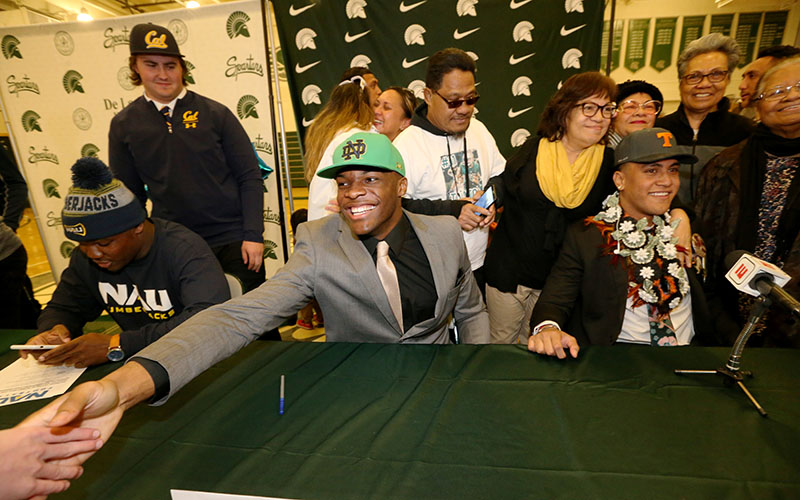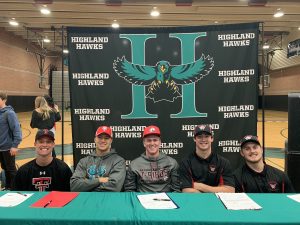
Wednesday’s National Signing Day was a big event at De La Salle High School in Concord, California, but it wasn’t at many other schools because of changes made by the NCAA. Among those who signed Feb. 6 were (from left) lineman Clayton Ingram, who committed to Northern Arizona; Isaiah Foskey, who’s off to Notre Dame; and Henry To’oto’o, who signed with Tennessee. (Photo by Ray Chavez/Media News Group/The Mercury News via Getty Images)
TEMPE – National Signing Day usually is one of the biggest days on the college football calendar. Fans of college football are glued to Twitter and television to see whether the country’s biggest recruits are going to their favorite university.
For the second straight year, however, Early Signing Day has stolen most of the luster of National Signing Day.
According to ESPN, 87 percent of its top 300 recruits signed in December on Early Signing Day. In the first year of the early signing period, that number was 74 percent.
Before the institution of the early signing period, the number of ESPN top 300 recruits who signed in December was 31 percent.
Greg Biggins, national recruiting analyst for 247 Sports, believes the early signing period has had a tremendous impact.
“It’s completely taken over what used to be one big day,” Biggins said. “It’s caused coaches to fast-forward on how they recruit. Recruiting in the summer is now probably the most important aspect of the player’s recruitment.”
Arizona State offensive coordinator Rob Likens wasn’t sure if he was going to like the early signing period, but it’s turned out to have its benefits.
“I love it. From a selfish side, it’s because there’s nothing worse than going through a football season, work your butt off, get a couple of days off at Christmas, but you’re really not off because you got to worry about your recruit going somewhere else,” Likens said. “Even if he’s committed, you’re still recruiting him. It’s just a breath of fresh air having those guys signed, and just sitting back and just enjoy a couple of days.”
Danny Gonzales, ASU assistant head coach and defensive coordinator, also loves the early signing period.
“Back in the day, when you were in recruiting, there was one signing day,” Gonzales said. “January was miserable because you’re babysitting 25 guys, and as a coordinator, you’re talking to 12 or 13 of them on your side of the ball every day. The focus has been taken off of that whole month of January for those guys. You don’t have to babysit anymore.”

ESPN reports that 87 percent of its top 300 football recruits signed in December on Early Signing Day. However, Highland High players (from left) Austin McNamara, Kyle Hester, Kohner Cullimore, Cooper Homan and Griffin Nielson signed their National Letters of Intent on Feb. 6. (Photo courtesy of Highland Hawks FB Twitter)
A side effect from the early signing period is the shortened window to make official visits to players’ homes. Likens, in preparation for the Las Vegas Bowl, contacted freshman quarterback Ethan Long and had to tell him he couldn’t make it out to his home in West Linn, Oregon, before signing with Arizona State.
“It’s pretty customary for the head coach to go and take a home visit in the kid’s home,” Likens said. “With the early signing period, it’s just hard to get to everybody’s home and usually the committed guys, you try to get in their home in maybe January because they’ve been committed for a long time.
“I said, ‘Ethan, I don’t know if you we’re going to be able to make it to your house before signing day, but we can get to it afterwards or whatever. He said, ‘Coach, what are you talking about? I’m coming to ASU. I don’t care if you come to my house or not. You guys need to win that bowl game.'”
Biggins believes the early signing period is beneficial for teams but is unsure if it’s beneficial for all players.
“It seems like the benefit of having an early (signing) period and a late period allows coaches to lock up their players and focus on football,” Biggins said. “I think there are benefits for some of the smaller schools who can lock their players in and not have to worry about the bigger schools coming in late and poaching them.”
A negative aspect for the early signing period, according to Biggins, is that December is the month with the most coaching changes. A player could sign with the team only to see a coach or the primary recruiter leave for a different school.
Also, a team could give a recruit an ultimatum: accept the scholarship now or lose your spot on the team.
“For example, a school like Fresno State is going to say, ‘Hey, if you don’t sign with us right now, your spot’s gone.’ Those schools are able to find out who’s really committed to them,” Biggins said. “If a player is committed but doesn’t want to sign, you’re probably going to say, ‘Hey, he’s not really locked in. He’s not 100 percent in.'”
The current signing day format is not perfect though. This year, the two signing days were separated by just seven weeks.
“I don’t necessarily like it so close together,” Biggins said. “I would do it like basketball where they have one right at the beginning of their season and then at the end of the season. You still give players a chance to go out and blow up and have a great senior year. You still allow those players to get opportunities. But then you also allow kids to get a run before the year starts and kind of just focus on football.”
In the end, Likens loves the early signing period after some early reservations.
“I love the fact that when you go back in January, you are way more concentrated on the 2020 and 2021 class and doing your homework,” Likens said. “Now, instead of in the past where you would go out in the spring and locate guys, now it’s backed it all up. Now, we’re locating them in December, and you plan out exactly where you are in the spring. I love it. I didn’t know how I was going to like it, but I love it.”
Connect with us on Facebook.